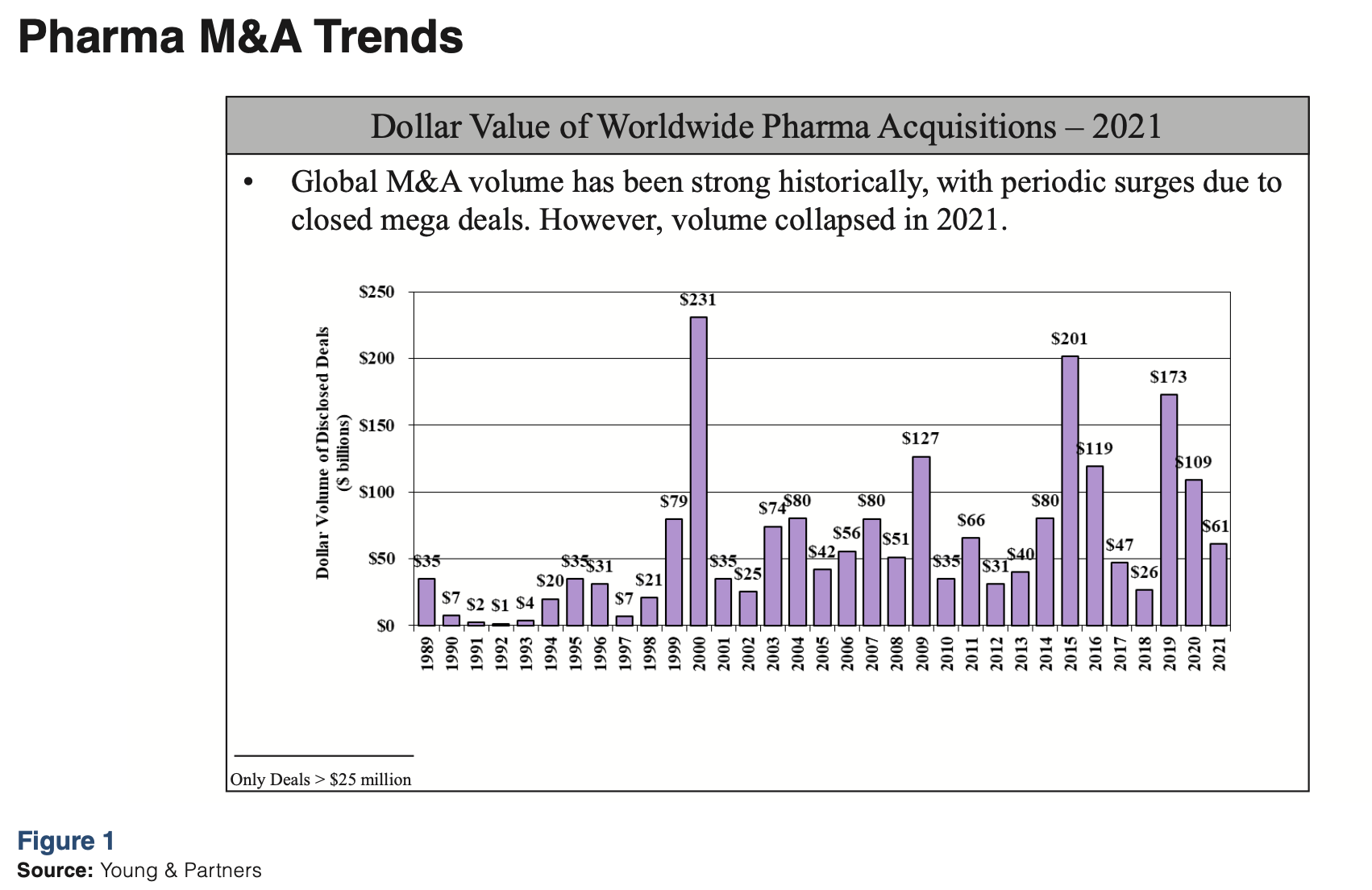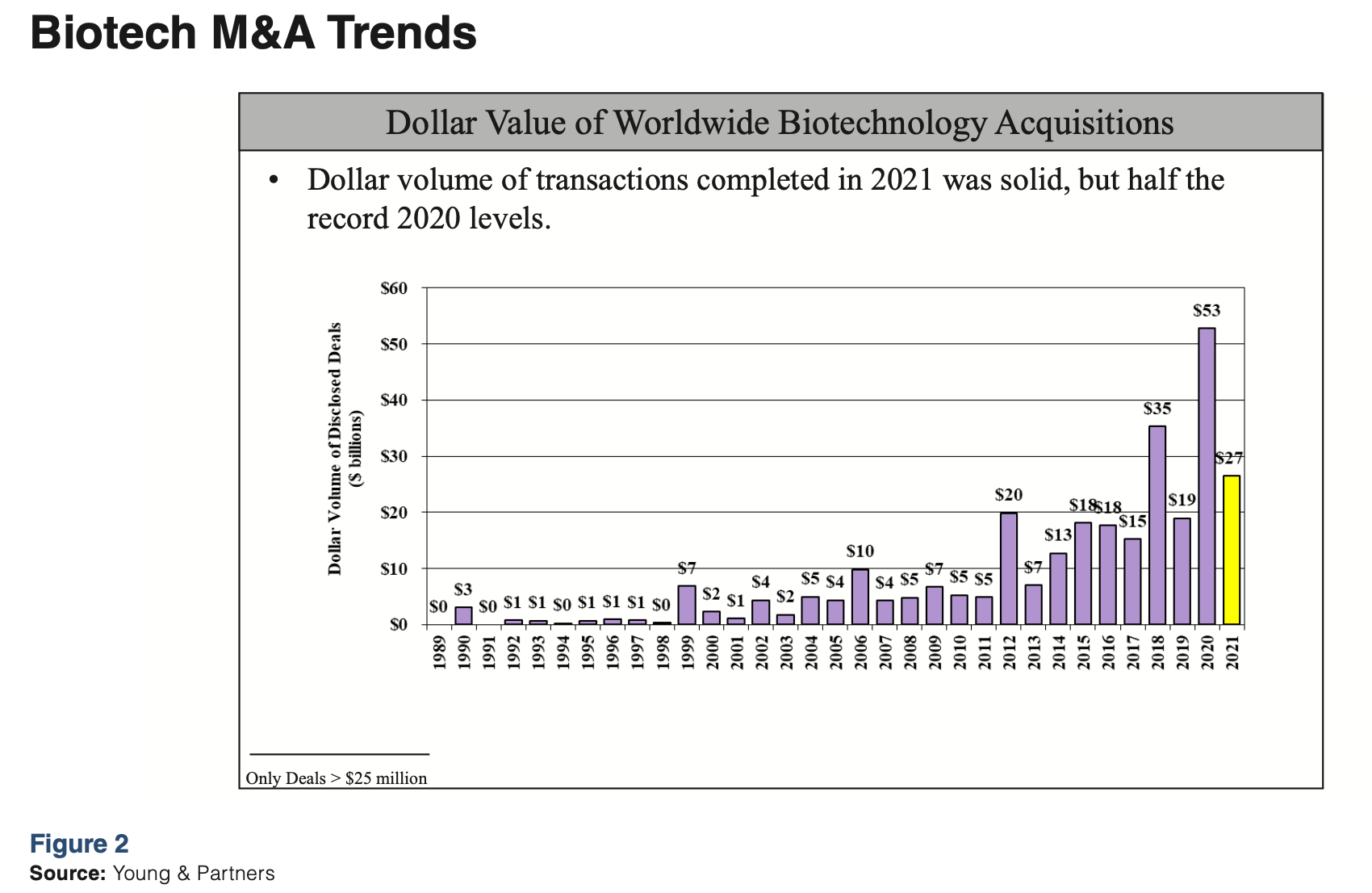Biopharma in 2021: Big Gains, Volatile Values
Full-year business review of pharma and biotech sectors reveals strong momentum in advancing novel science and treatments, but likely foretells continued stock instability in near-to-medium terms.

In many respects, 2021 was a positive experience for the pharma and biotech industries. It was an extraordinarily successful year for innovation and new drugs. In particular, it was a spectacular demonstration of the biopharma industry’s ability to have a huge impact on human health with the successful development of COVID-19 vaccines. FDA drug approvals hit 55 new molecular entities in 2021, and the European Medicines Agency (EMA) approved 92 new medicines. Government funding of organizations, such as the NIH in the US, continued to be strong as governments around the world recognized the importance of the biopharma industry. Growth prospects for the industry as a whole remain very attractive.
There are exciting opportunities in areas such as new vaccine technologies (mRNA, etc.) that will provide much broader horizons for the types of vaccines that might be developed for diseases beyond COVID. The shift from small molecular weight drugs to macromolecules is being enhanced by new technologies to develop, manufacture, and use these, even in asthma, with the emergence of anti-IgE and eosinophilic antibodies. It is our belief that the whole therapeutic field will likely look very different over the next few years, and the research and commercial profile of both large- and small-molecule drugs will change dramatically, including on the manufacturing side.
However, there continue to be clouds overhead as we see that the cost of drug development and approvals remains sky high, criticism regarding drug prices and the threat of controls continues in certain countries, generic drug companies are struggling to grow and maintain profitability, the scrutiny of orphan-drug pricing is increasing, price and formulary pressures from payers continue, and structural changes are ongoing in healthcare and government policies in large countries such as the US and China.
For part of the year, public company valuations—except for generics—were high, and the image of the industry went from somewhat negative to very positive. In addition, biotech companies were able to raise large amounts of capital.
But not all went well in 2021. There was slippage in the valuations of many of the larger biopharma companies. The share prices of the NBI broader group of biotech companies did not perform well. This has spilled over into the new year as the stock market overall and the biopharma sectors suffered setbacks in the early part of 2022.
These factors and other structural changes have had a major impact on the strategies of all the companies in the biopharma ecosystem and have impacted the texture of the M&A, financing, strategic partnering and licensing, and other strategic/financial parameters of the industry.
The rest of this article will look at what happened from an M&A, stock market, and financing point of view in 2021 and what we expect will happen in 2022 and beyond. The implications of these trends for senior executives and investor decision-makers in the pharma and biotech sectors will also be discussed.
Pharma equity market performance
During 2021, global equity markets continued to perform well, despite the economic uncertainties and ongoing pandemic. By the end of 2021, the S&P 500 had increased 28.9% and the S&P Euro 350 had grown by 21.9%.The overall picture for the pharma industry was positive and roughly in line with the very positive market performance. The Young & Partners (Y&P) US Biopharma Index increased by 26.7%, the European Biopharma Index rose by 23.6%, and the Y&P Generic Pharma Index decreased by 21%.
The year-end 2021 Y&P US Pharma Index average price-to-earnings (P/E) ratio declined, and the European Pharma Index increased versus year-end 2020. As a result of their underperformance, the Y&P Generic Pharma Index average of the P/E ratios continued to decline in 2021.
Pharma equity financing and M&A
Equity issuance dollar volume in 2021 totaled $17.8 billion vs. $27.3 billion for all of 2020. This is a major slowdown in dollar volume, but the number of offerings rose to a record level. There were 92 offerings in 2021 vs. 85 offerings in 2020.
In essence, the industry is executing a large number of smaller equity offerings. The most dramatic financial trend development has been the continued subdued activity with regard to pharma-initiated M&A volume. There were only 14 M&A transactions in 2021, worth $61.2 billion, a dramatic decrease from the pace exhibited in recent years. Only three were greater than $1 billion in value. In 2020, a total of 25 deals were completed, worth $109.1 billion.

The relative focus of large pharma manufacturers has been on acquiring biotech companies and the use of strategic alliances, joint ventures, and in-licensing to achieve pipeline growth. There was far less focus on acquiring pharma companies. As of Dec. 30, 2021, the dollar value of deals announced but not closed was $15.1 billion (six deals), the largest of which was CSL’s $12.8 billion purchase of Vifor Pharma.
Biotech equity market performance
Biotech sector shares have done very well in recent years, fueled by positive news about biotech drug development and the positive perception of the biopharma industry, but performance last year was variable by size. As indicated earlier, larger biopharma companies performed well last year, as did the small- to medium-cap biotech companies. The Y&P Biotech Mid-Small Cap Index increased by 21.6%. However, the broader NBI Biotech Industry Index performed poorly and was flat for the year.
Biotech equity financing and M&A
The positive story with regard to biotech equity offerings continued in 2021. The overall volume of equity offerings was very strong, with 360 offerings worth $52.1 billion completed in 2021 vs. 379 worth $56.9 billion completed in 2020, continuing at the same high level.
In terms of IPOs, the volume in 2021 surpassed 2020 by a large margin. One-hundred-and-twenty-six IPOs were completed worth $26.7 billion, compared to 90 IPOs worth $17.5 billion in all of 2020. These are record levels.
Biotech M&A activity has been modest historically, with small spurts of activity from time to time. However, that changed starting from a few years ago and continued in 2021 in terms of the number of deals. In 2021, deal-output activity exceeded the number of deals in 2020, but the dollar volume fell dramatically. Forty-seven deals worth $26.5 billion were completed versus 33 deals worth $52.8 billion in 2020. Deals were happening at an earlier stage, which contributed to the smaller average deal size and the lower dollar total. The dollar value of biotech pipeline of deals as of Dec. 31, 2021, was $13.1 billion (11 deals).

Outlook: Pharma
Business
The business outlook for pharma companies continues to be positive with regard to drug development, with promising products in the pipeline. The industry’s drug development innovation and productivity has improved after a long period of lower productivity. When combined with the healthy contribution of acquired and partnered drugs from the biotech industry, the overall development activity has been strong and should continue to be.
There has been a shift in emphasis toward orphan drugs, oncology therapies, new innovations such as cell and gene therapy, CAR-T, immune system solutions, CRISPR, etc.
The current pandemic has been a plus for the reputation of the industry, but a negative with regard to the obstacles that the pandemic has created for those executing clinical trials and the maintenance of industry supply chains.
Generic pharma companies will remain be under severe profit pressures and will continue to consolidate, cut costs, and try to push selectively into higher value and more protected product areas.
Equity markets
It is our expectation that the biggest driver for biopharma share prices will be the performance of the broader equity markets. They are under great pressure now with the prospect of higher interest rates and the high inflation levels. Predicting what the broader markets will do throughout 2022 is a challenge.
However, the positive pharma news is offsetting the negative news from the point of view of investors. As a result, ethical drug companies will continue to experience positive treatment in the stock market. Generic pharma company share prices will continue to suffer as these companies deal with serious business issues and pressures.
Equity financing
We expect the equity financing market for pharma to be modest but healthy. The pharma industry tends not to raise new equity very often unless an individual company has to raise equity to repair its balance sheet after an acquisition. Since M&A activity has not been as substantial, financing needs continue to be modest.
M&A
Young & Partners expects M&A activity to continue to be modest in terms of both dollars and number of deals in 2022. Most of the market focus will be on medium-sized deals and the number of deals will be less than last year.
Deals with a strong strategic rationale or a theme around adding new and growing technologies and products will continue to be pursued. Mega deals that merge existing, mature biopharma companies are no longer being targeted.
More of the M&A activity will continue to be directed toward the acquisition of biotech companies. In addition, most of the attention will be on in-licensing arrangements, partnerships, and joint ventures with biotech companies and other pharma organizations.
Outlook: Biotech
Business
The development capabilities of biotech companies have been and will continue to be positive overall, with an escalation in the scale and speed of innovation. The prevalence of new technologies and orphan-drug opportunities will be the driver for commercial innovations in the years to come. Although there will be successes and failures by individual companies, biotechs have demonstrated their ability to develop new drugs at a faster pace than larger pharma companies. There will, however, be an ongoing change in the competitive dynamics with the rise of the Chinese biotech ecosystem, including equity funding, and the constantly shifting mix of technologies and their origins.
Equity markets
Recently, there has been some weakness and volatility in the performance of biotech stocks, but we expect the market will rebound and strongly support biotech companies in the future. The positive view of the biopharma industry and the regular announcements of successful R&D discoveries and clinical trials should fuel the positive stock market treatment of the biotech industry long term; but the road will be bumpy in the near-to-medium term.
The recent weakness and volatility have been driven by problems with the broader stock market picture, news stories around pricing, and the concern that biotech and technology stocks, in general, are at unsustainable valuation levels. We believe price volatility will continue, driven by bouts of positive and negative industry news.
Equity financing
This will be a solid year for biotech company funding but not as strong as 2021. Biotech companies will continue to tap the equity markets at a decent pace for the rest of 2022 and beyond for both IPOs and secondary offerings as long as the market continues to favor biotechs. This will be a strong year for biotech company access to funding, as biotech companies access the equity markets and pursue partnering, licensing, and royalty monetization for funding and shareholder liquidity.
M&A
M&A volume in terms of number of deals will be strong in 2022, but dollar volumes will lag behind last year’s total. Buyer interest will be focused on specific targets in favored therapeutic and technology areas and on biotech companies that have made significant clinical progress. However, there will continue to be a high volume of partnering, licensing, and royalty monetization for funding and shareholder liquidity.
Implications for senior management
For ethical pharma companies, there will continue to be a wide variety of tools to acquire revenues and pipeline drugs beyond their internal R&D efforts, with a large number of biotech company opportunities available. However, M&A valuations will continue to be high and risky, particularly for companies with promising drugs in late-stage clinical trials or awaiting FDA approval. But there will be ample opportunities for partnering and in-licensing deals.
The challenge for senior management will be to pick the right overall mix of M&A, licensing, and partnering to accomplish corporate strategic goals and defend and deliver shareholder value.
Generic pharma companies will continue to face a number of industry challenges. This will result in a continuation of industry consolidation and selective strategies around diversification. CEOs of generic pharma organizations must be prepared to shift to very different strategies to survive and thrive.
For biotech companies, public and private, the future is bright in terms of drug development and innovation. However, there will be greater risks when it comes to IPO financing, with a more nervous investor universe where valuations will be lower. M&A as an exit vehicle will continue to be strong but selective.
This means that biotech companies should be more conservative about the amount of equity they raise, if they are private, so that they have more flexibility. Each company must properly assess its cash flow requirements, and create and execute a flexible financing/M&A plan that properly assesses how much capital is needed and what will create the most shareholder value, whether it is through private placements, partnering, IPOs and secondary offerings, royalty monetizations, or sources of nondilutive financing. However, the lay of the land will vary greatly by each company with regard to therapies, technologies, cash requirements, and stages of development.
Looking forward, it will be important for leaders to have an integrated business and financial/shareholder value strategy. A company can easily pursue a development/business strategy that optimizes the odds of a successful product outcome, but it may not create the best financing and shareholder value/liquidity result.
Peter Young is CEO and President of Young & Partners, and a member of PharmExec’s Editorial Advisory Board. He can be reached at pyoung@youngandpartners.com.

The Misinformation Maze: Navigating Public Health in the Digital Age
March 11th 2025Jennifer Butler, chief commercial officer of Pleio, discusses misinformation's threat to public health, where patients are turning for trustworthy health information, the industry's pivot to peer-to-patient strategies to educate patients, and more.
Navigating Distrust: Pharma in the Age of Social Media
February 18th 2025Ian Baer, Founder and CEO of Sooth, discusses how the growing distrust in social media will impact industry marketing strategies and the relationships between pharmaceutical companies and the patients they aim to serve. He also explains dark social, how to combat misinformation, closing the trust gap, and more.
Regeneron, Roche Launch Major US Expansion Plans to Meet Growing Demand for Biologics and Innovation
April 22nd 2025With combined investments exceeding $53 billion, both companies are deepening their US presence through expanded biologics production, gene therapy capabilities, and next generation R&D centers.

.png&w=3840&q=75)

.png&w=3840&q=75)



.png&w=3840&q=75)



.png&w=3840&q=75)




















